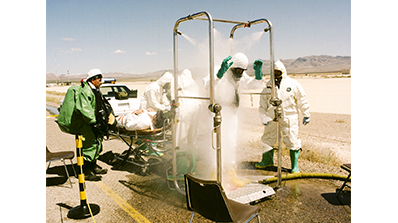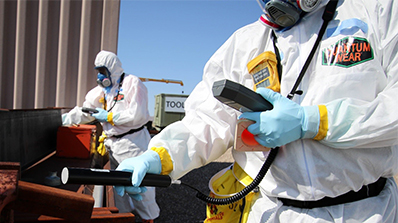Twenty years ago, the Nevada National Security Site’s Counter Terrorism Operations Support (CTOS) program trained its first emergency responders on how to respond to radiological and nuclear threats. To date, CTOS has trained a total of 220,900 first responders! There is no doubt that CTOS training has substantially contributed to national preparedness, ensuring the nation’s first responders are ready to successfully handle events involving radiological or nuclear terrorism.
Creating a program like CTOS was critical. Immediately following the 1995 Oklahoma City bombing, first responders were unprepared to deal with weapons of mass destruction. Soon after, the National Domestic Preparedness Consortium (NDPC) was formed – originally under the Department of Justice before it eventually found a home under the Federal Emergency Management Agency (FEMA). With state and local agency training budgets constrained, NDPC made the case for a national training program. As a result, CTOS was born.
“CTOS stresses that first responders should train as if their life depends on it, because it does,” said Dave Pasquale, CTOS project manager.

The CTOS team continually adjusts its parameters to be in line with real-world scenarios. They use the services of more than 80 instructors – subcontractors who are current or retired law enforcement, military, fire and emergency medical services professionals, allowing the right instructor to teach the right audience (such as police officers teaching police officers). Training and course materials are provided at no cost to eligible participants. The program also recently debuted its first Spanish online course.
CTOS instruction is performance-based and uses multiple types of radioactive material, controlled in a safe and secure manner. Operating and employing radiation detection and measurement instruments throughout the course, participants train with radioactive material in the classroom, scenario-based drills and performance evaluations.
And what better place to train for radiological/nuclear events than at a historic site that conducted 928 nuclear experiments? The small amount of nuclear fallout remaining from these detonations is now below the surface of the soil at the T-1 Site at the NNSS. Formerly known as the Nevada Test Site, the Site’s entrance is located 65 miles northwest of Las Vegas. This provides a realistic and safe training area today. The soil at the T-1 Site emits low levels of radiation, which simulates widespread radiological contamination from an improvised nuclear device or multiple radiological dispersal devices, yet poses minimal risk to participants. (Courses are designed so participants receive only minor radiation doses—lower than a chest X-ray or a typical round-trip airline flight across the United States.) Fortunately, even low levels of radiation are sufficient to learn techniques required in an actual incident involving much higher radiation levels.

Adding to the realism, radioactive debris created during the nuclear tests, such as twisted steel fragments and sand melted into radioactive glass (trinity glass or trinitite), are still scattered throughout the T-1 Site. Industrial, sealed radioactive sources are also placed in exercise areas to create higher levels of radiation as needed for training objectives.
All training goes through a certification process with FEMA and is National Incident Management System (NIMS)-compliant, which standardizes the incident command process, allowing professionals from other areas to easily integrate as needed.
To learn more about the CTOS program, please enjoy this video: https://www.youtube.com/watch?v=1BsnbDYKUnM&t=9s or visit our CTOS webpage.

